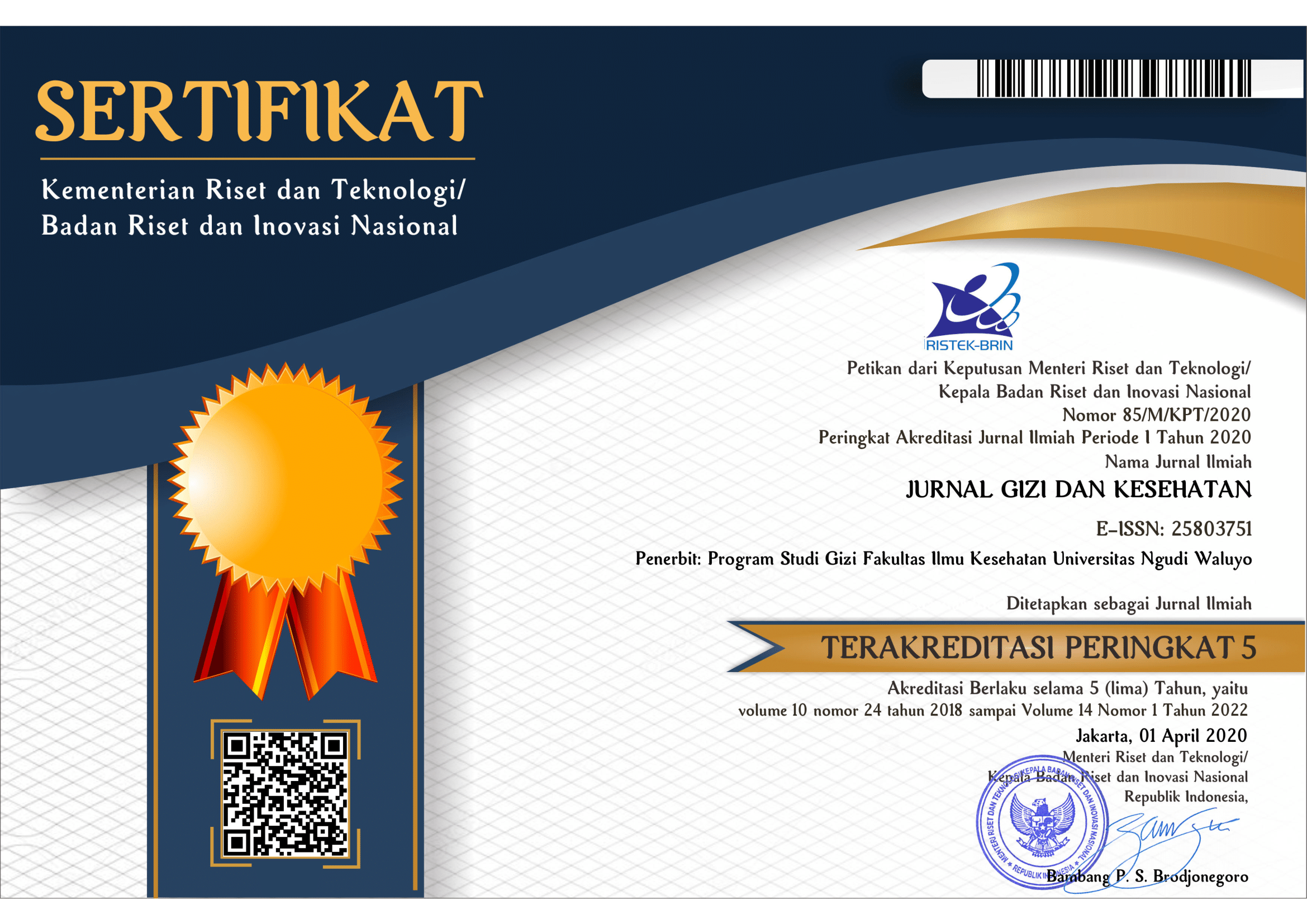The Relationship of Dietary Intake and Nutritional Status to the Risk of Eating Disorders among University Students in Yogyakarta, Indonesia
DOI:
https://doi.org/10.35473/jgk.v17i1.731Keywords:
anorexia, eating disorder, BI, dietary intake, food record, nutritional statusAbstract
Eating disorders are linked to poor nutritional status, often driven by dietary inadequacies such as caloric restriction or unhealthy eating behaviors. A university student was a vulnerable group in terms of susceptible to develop eating disorders. Understanding how dietary intake and nutritional status contribute to eating disorders’ risk is essential. This study aim to examining the relationship between dietary intake, nutritional status, and eating disorders’ risk among university students in Yogyakarta, Indonesia. We conducted a cross-sectional study in June-August 2024, assessing dietary intake via a 24-hour food record and analyzing nutritional status by body mass index (BMI). Eating disorders’ risk was measured using the EAT-26 questionnaire. Results indicated that 90.4% of students had deficient dietary intake, 4.8% low dietary intake, and the rest were moderate and adequate. While 11.9% students were underweight, 52.4% had normal BMI, and the remainder were overweight or obese. Dietary intake did not significanly related with eating disorders’ risk, but nutritional status significantly relateated (p 0.033). In conclusion, most participants had energy intake deficits but dietary intake was not significantly associated to eating disorders’ risk. Nutritional status, however, was significantly associated with eating disorders’ risk, with underweight individuals being particularly vulnerable.
Downloads
References
American Psychiatric Association. 2013. Diagnostic and statistical manual of mental disorders (5th ed.). Washington, DC: American Psychiatric Press.
Andres, A. and Saldana, C. 2014. Body dissatisfaction and dietary restraint influence binge eating behavior. Nutrition Research; 34(11): 944-950. DOI: 10.1016/j.nutres.2014.09.003.
Asna, A. and Syah, M. N. H. 2021. Eating disorders risks and over intake of energy and macronutrients among girl students in Mitra Keluarga School of Health Sciences. Indonesian Journal of Nutritional Science; 1(1): 2-7. DOI: 10.52023/ijns.v1i1.2517.
Barakat, S., McLean, S. A., Bryant, E. et al. 2023. Risk factors for eating disorders: findings from rapid review. Journal of Eating Disorders; 11(8): 1-31. DOI: 10.1186/s40337-022-00717-4.
Begdhace, L., Sadeghzadeh, S., Derose, G. et al. 2020. Diet, exercise, lifestyle, and mental distress among young men and women: a repeated cross-sectional study. Nutrients; 13(1): 24. DOI: 10.3390/nu13010024.
Center for Disease Control and Prevention (CDC). 2000. Body Mass Index: Considerations for practitioners. pp. 1-4.
Chavez, M. and Insel, T. R. 2007. Eating disorders: National Institute of Mental Health's perspective. American Psychologist; 62(3): 159–166. DOI: 10.1037/0003-066X.62.3.159.
Choirunnisa, R. and Harahap, F. 2023. Body image and eating behaviors among university students. Psychological Research and Intervention; 6(2): 75-83. DOI: 10.21831/pri.v6i2.65165.
Eck, K. M., Quick, V. and Byrd-Bredbenner, C. 2022. Body Dissatisfaction, Eating Styles, Weight-Related Behaviors, and Health among Young Women in the United States. Nutrients, 14(18): 38-76. DOI: 10.3390/nu14183876.
El-Far, D. 2023. The Impact of Nutrition on the Mental and Physical Health of Young Adults. WRIT: Journal of First-Year Writing; 5(1):1-21. DOI: 10.25035/writ.05.01.01.
Feng, B., Harms, J., Chen, E. et al. 2023. Current Discoveries and Future Implications of Eating Disorders. International Journal of Environmental Research and Public Health; 20(14): 6325. DOI: 10.3390/ijerph20146325.
Garner, D. M., Olmsted, M. P., Bohr, Y. and Garfinkel, P. E. 1982. The eating attitudes test: Psychometric features and clinical correlates. Psychological Medicine; 12: 871–878. DOI: 10.1017/S0033291700049163.
Gurnida, D. A., Nur’aeny, N. and Hakim, D. D. L. et al. 2020. Correlation between nutritional adequacy levels with body mass index of elementary school students grades 4, 5, and 6. Padjadjaran Journal of Dental Researchers and Students; 4(1): 43. DOI: 10.24198/pjdrs.v4i1.25763.
Hebebrand, J. and Bulik, C. M. 2011. Critical appraisal of the provisional DSM-5 criteria for anorexia nervosa and an alternative proposal. International Journal of Eating Disorders; 44(8): 665-78. DOI: 10.1002/eat.20875.
Hudson, J. I., Hiripi, E., Pope Jr., H. G. and Kessler, R. C. 2007. The prevalence and correlates of eating disorders in the National Comorbidity Survey Replication. Biological Psychiatry; 61(3): 348-58. DOI: 10.1016/j.biopsych.2006.03.040.
Institute of Medicine (US) Subcommittee on Interpretation and Uses of Dietary Reference Intakes; Institute of Medicine (US) Standing Committee on the Scientific Evaluation of Dietary Reference Intakes. 2000. DRI Dietary Reference Intakes: Applications in Dietary Assessment. Washington (DC): National Academies Press (US). Available from: https://www.ncbi.nlm.nih.gov/books/NBK222882/.
Kiani, A. K., Dhuli, K. and Donato, K. et al. 2022. Main nutritional deficiencies. Journal of Preventive Medicine and Hygiene; 63(2S3): 93–101. DOI: 10.15167/2421-4248/jpmh2022.63.2S3.2752.
Kriaucioniene, V., Grincaite, M. and Raskilie, A. 2023. Changes in Nutrition, Physical Activity, and Body Weight among Lithuanian Students during and after the COVID-19 Pandemic. Nutrients; 15(18): 4091. DOI: 10.3390/nu15184091.
Latkin, C. A., Edwards, C., Daver-Rothwell, M. A. and Tobin, K. E. 2017. The relationship between social desirability bias and self-reports of health, substance use, and social network factors among urban substance users in Baltimore, Marylan. Addictive Behaviors; 73: 133–136. DOI: 10.1016/j.addbeh.2017.05.005.
Malaram, G. K., Sharma, P. and Kattula, D. et al. 2023. Body image perception, eating disorder behavior, self-esteem and quality of life: a cross-sectional study among female medical students. Journal of Eating Disorders, 11: 225. DOI: 10.1186/s40337-023-00945-2.
Maurizio, M. 2021. The Impact of Nutrients on Mental Health and Well-Being: Insights From the Literature. Frontiers in Nutrition, 8. DOI: 10.3389/fnut.2021.656290.
Milic, J., Stankic, D. and Stefanovic, D. 2023. Eating Disorder and Quality of Life, in Patel, V.B. and Preedy, V.R. (eds) Eating Disorders. Springer, Cham. DOI: 10.1007/978-3-031-16691-4_21.
Moschonis, G. and Trakman, G. L. 2023. Overweight and Obesity: The Interplay of Eating Habits and Physical Activity. Nutrients; 15(13): 2896. DOI: 10.3390/nu15132896.
Puspita, B., Lestari, A. and Andayani, T. R. 2024. The Relationship between Fad Diet, Body Image, Stress, Peer Pressure with Eating Disorders in Adolescent Girls Aged 16-18 Years. Amerta Nutrition; 8(1): 49-57. DOI: 10.20473/amnt.v8i1.2024.49-57.
Ravelli, M. N. and Schoeller, D. A. 2020. Traditional Self-Reported Dietary Instruments Are Prone to Inaccuracies and New Approaches Are Needed. Frontiers in Nutrition; 7:90. DOI: 10.3389/fnut.2020.00090.
Saunders, J. and Smith, T. 2010. Malnutrition: causes and consequences. Clinical Medicine (London); 10(6):624–627. DOI: 10.7861/clinmedicine.10-6-624.
Shook, R. P., Blair, S. N. and Duperly, J. et al. 2014. What is causing the worldwide rise in body weight. European Endocrinology; 10(2): 136–144. DOI: 10.17925/EE.2014.10.02.136.
Smink, F. R. E., van Hoeken, D. and Hoek, H. W. 2013. Epidemiology, course, and outcome of eating disorders. Current Opinion in Psychiatry; 26(6): 543-548. DOI: 10.1097/YCO.0b013e328365.









